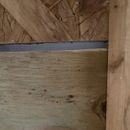gaps between sheathing and sill plate
hi.
i live in wilmington,nc
i replaced rotted osb boards and where it is installed there are some places where i see daylight where sheathing meets the sill plate. on the exterior side is tyvek and hardiplank . do i need to seal these places before batt insulation is installed, or leave as is? and where the sill plate meets slab..thanks
also second photo is where the new sheathing buts up to the old. the horizontal gap in one area is just under 1/4 inch should i caulk this?
thanks for the help
GBA Detail Library
A collection of one thousand construction details organized by climate and house part











Replies
nospeak,
If the gaps are covered by siding and Tyvek such that rain and pests can't get in, what's important for the walls is that they are air-sealed. You want to stop air m0ving through them, both to conserve energy, and to stop the moisture that is in the air causing problems in the walls.
The way this is done is by having a continuous air-barrier. That barrier can be a few different things, and be in a few different places. It an be the drywall, a sheet material like poly, the sheathing or the house-wrap - as long whichever one you choose is detailed appropriately - that is, they are sealed and continuous.
So whether it's important to seal the gaps in your OSB, or under the sill-plate, depends on where and what your air-barrier will be. Whatever layer you choose, is where you need to put your attention to sealing.
so basically i will have sheetrock, batt insulation, osb sheathing, tyvek house wrap and hardiplank siding in that order from inside to outside . everything is done from the sheathing out. next week insulation and sheetrock will be installed.
so i am concerned about the air gap in some areas between the sill plate and the sheathing. people say it should be left as is so the wall can breathe and others say to seal it. so do i and if so with what. so i am not really sure. And were the sill plate meets the slab, the original silicone is peeling away and i will just scrape and clean and reapply silicone.
Wall don't need to breath. There is no benefit to having air move through them.
What my first post was getting at is that sealing those gaps is only useful if you are choosing the sheathing as your air barrier. And if that's what you choose, then you need to not only seal the gaps you see, but all the gaps between the sheets of sheathing and framing you perhaps haven't noticed. You can certainly do that, or you can choose to seal either a sheet material under the drywall, (poly or a variable perm membrane) or seal the drywall - which means you wouldn't need to worry about those gaps.
So what does that mean in your situation where the siding, sheathing and Tyvek are already in place? Your easiest choices are to:
- Caulk the perimeter of each stud bay where the framing meets the sheathing, and tape the seams between the sheets of OSB where they are visible.
-Decide to use a membrane under the drywall which you will completely seal around the perimeter.
- Seal the drywall at the perimeter and any openings.
Whichever option you choose, you will need to seal the sill-plate to the floor with caulking or tape.
thanks....
i will definitely seal those gaps with low expansion foam.
the problem for my moisture problem was that there was a double vapor barrier. there was sheetrock then plastic then insulation then osb, then tyvek then hardiplank.
i was worried that not having an escape for moisture i would have the same problem again...
so basically since tyvek is being used i will seal up any visible daylight gaps with foam except to use silicone between the sill plate and slab.
is it possible to use silicone in the other areas we are talking about as well.
Malcolm, thanks so much for passing all this info to me....!!!
Yes silicone caulk will work everywhere, except perhaps the wider gaps between the sheets of OSB. Tape might be better there.
Nice to have the rot gone and the walls fixed isn't it?
lol....absolutely
i really appreciate all the info you provided.
thank you